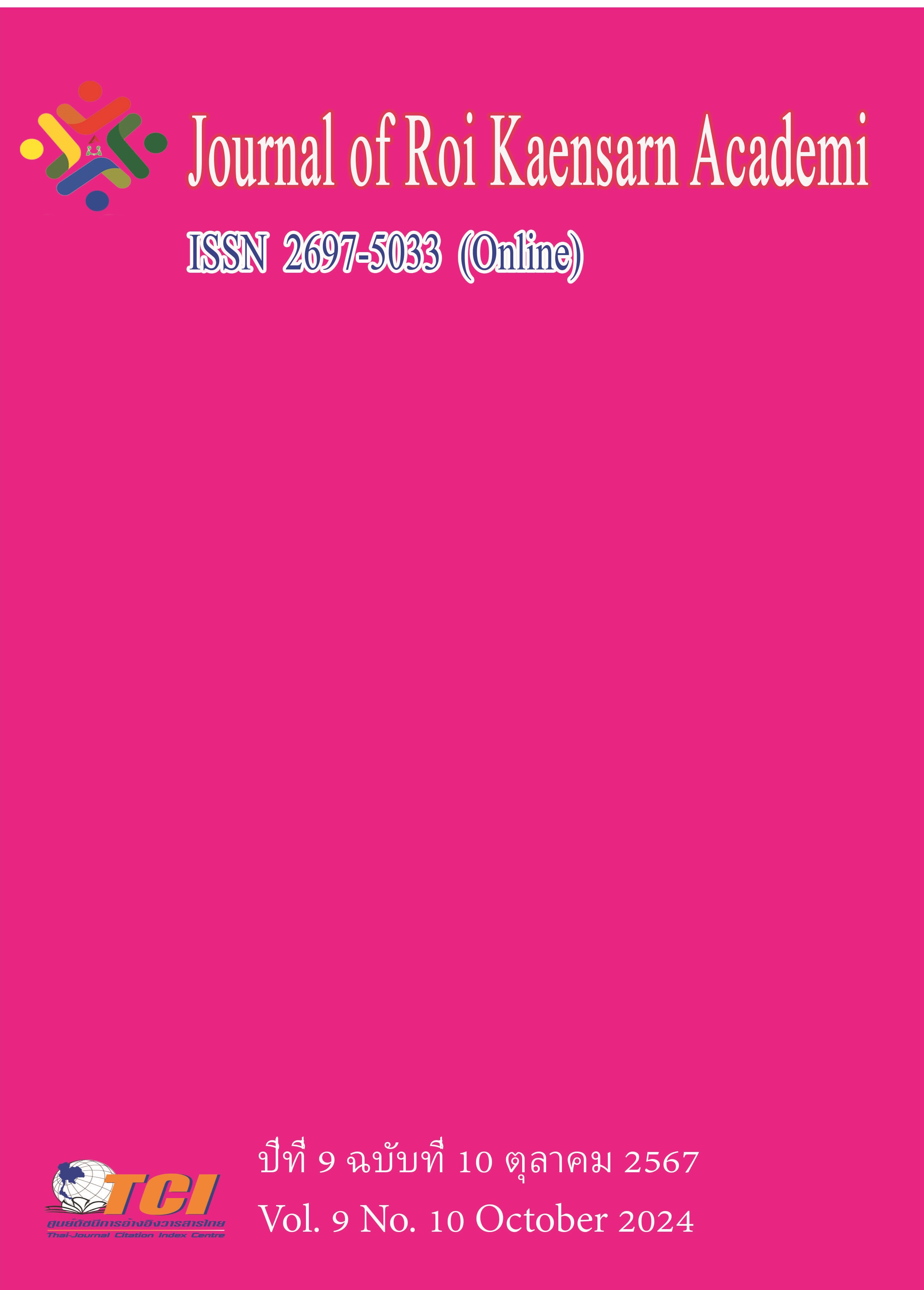A Causal Model of Talent Management on Organizational Performance: An Empirical Study of SF Listed Logistics Enterprises in China
Main Article Content
บทคัดย่อ
Objectives: The objectives of this study are: 1) To determine the factors of talent management that significantly impact the organizational performance of SF listed logistics companies. 2) To determine how the organizational commitment variable as a mediator impacts the organizational performance of SF listed logistics companies. 3) To develop a model of talent management for the organizational performance of SF logistics enterprises in China.
Research Method: The quantitative method and in-depth interview method of purposeful sampling technique were used in this study.
Samples: This study takes SF Express as an example, which is the largest company in China in terms of business scale, number of employees, and business scope.
Instrument: Questionnaires were distributed to 420 SF Express employees, 406 valid questionnaires were received, and in-depth interviews were conducted with 21 managers.
Analysis: The conclusion of this study comes from the data analysis and statistics of SPSS and AMOS software.
Results: This study studies the relationship between talent management and organizational performance of SF Express-listed logistics companies. The results show that there is a significant correlation between talent management, organizational commitment, and organizational performance, and organizational commitment plays an intermediary role in these relationships.
Article Details
เอกสารอ้างอิง
Adnan, S., Nhaily, A., & Wang, H. (2018). To Evaluate and Study the relationship between employees’ commitment and individual performance: A Quantitative Approach-Case Study of Kansai Paints. https://www.divaportal.org/smash/get/diva2:1216918/ FULLTEXT01.pdf
Afeshat, R. A. (2019). The role of high-performance work system practices in organizational performance: the mediating role of employees’ engagement and the moderating role of servant leadership: evidence from the airline industry. https://irep.emu.edu.tr:8080/ jspui/bitstream/11129/5047/1/Afeshatrawan.pdf
Almohtaseb, A. A., Shaheen, H. A. K., Alomari, K. M., & Yousef, M. A. (2020). Impact of talent management on organizational performance: The moderating role of an effective performance management system. International Journal of Business and management, 15(4), 11-24. https://doi.org/10.5539/ijbm.v15n4p11
Alparslan, A., & Saner, T. (2020). The Influence of Sustainable Talent Management on Job Satisfaction and Organizational Commitment: Moderating Role of In-service Training. Revista de cercetare si interventie sociala, 69. https://www.ceeol.com/search/article-detail?id=879032
Anderson, J. C., & Gerbing, D. W. (1988). Structural equation modelling in practice: A review and recommended two-step approach. Psychological bulletin, 103 (3), 411. https://doi. org/10.1037/0033-2909.103.3.411
Andrew, A. (2017). Employees’ commitment and its impact on organizational performance. Asian Journal of Economics, Business and Accounting, 5 (2), 1-13. https://doi.org/10. 9734/AJEBA/2017/38396
Arasanmi, C. N., & Krishna, A. (2019). Employer branding: perceived organisational support and employee retention–the mediating role of organisational commitment. Industrial and commercial training, 51 (3), 174-183. https://doi.org/10.1108/ICT-10-2018-0086
Bentler, P. M., & Yuan, K.-H. (1999). Structural equation modelling with small samples: Test statistics. Multivariate behavioural research, 34 (2), 181-197. https://doi.org/10.1207/ S15327906Mb340203
Chih-Pei, H., & Chang, Y.-Y. (2017). John W. Creswell, research design: Qualitative, quantitative, and mixed methods approaches. Journal of Social and Administrative Sciences, 4 (2), 205-207. https://doi.org/10.1453/jsas.v4i2.1313
Collings, D. G., & Mellahi, K. (2019). Strategic talent management: A review and research agenda. Human resource management review, 19 (4), 304-313. https://doi.org/10. 1016/j.hrmr.2009.04.001
Dhaka, L. Y. X. (2022). Study on Human Resource Management Optimization in large logistics enterprises in China. Logistics engineering and management, 44 (4), 149-151.
Dost, M. K. B., Ahmed, Z., Shafi, N., & Shaheen, W. A. (2017). Impact of employee commitment on organizational performance. Arabian Journal of Business and Management Review, 1 (3), 87-98.
El Dahshan, M., Keshk, L. I., & Dorgham, L. S. (2018). Talent management and its effect on organization performance among nurses at shebin el-kom hospitals. International Journal of Nursing, 5 (2), 108-123. https://doi.org/10.15640/jns.v5n2a10
Georges, F. (2020). Organizational Commitment: A Review of the Evolution from Side-Bets to The Three Component Conceptualisation Model. Global Journal of Management and Business Research, 20 (5), 27-32.
Haiyan, Z., & Shuwei, S. (2022). Empirical analysis of influencing factors of new generation employee dismission in r logistics enterprises from the perspective of salary gap. Logistics technology, 41 (6), 4.
Lamola, A., & Yamane, T. (1967). Sensitized photodimerization of thymine in DNA. Proceedings of the National Academy of Sciences, 58 (2), 443-446. https://doi.org/10.1073/pnas.58.2.443
Ling, M., Yu, W., & Yun, X. (2019). The relationship between job satisfaction, organizational commitment and job performance. Enterprise economy, 32 (5), 4.
Malkawi, E. (2017). The relationship between talent management and organizational commitment case study: Aqaba special economic zone authority, Jordan. International Business and Management, 14 (1), 80-84. https://doi.org/10.3968/9195
Masud, H., & Daud, W. N. W. (2019). Human resource management practices and organizational commitment: Research methods, issues, and future directions. Review of Integrative Business and Economics Research, 8, 217-226. http://buscompress.com/ journal-home.htm
Mishra, R. R., & Kumar, D. (2019). Talent Management: A Bird's-Eye Perspective. Mathan: Journal of Commerce & Management, 6 (2). https://doi.org/10.17492/manthan.v6i2. 187113
Najm, A., & Manasrah, A. K. (2017). The effect of talent management on organizational performance: an applied study in Jordanian banks. Review of Applied Socio-Economic Research, 13 (1), 36-51. http://www.reaser.eu
Nankervis, A. R. (2013). ‘Building for the future?’Government and industry responses to the challenges of talent management in China following the GFC. Asia Pacific Business Review, 19 (2), 186-199. https://doi.org/10.1080/13602381.2013.767635
Ogbari, M. E., Onasanya, Y. A., Ogunnaike, O. O., & Kehinde, O. J. (2018). Talent management as a determinant of firm performance: A conceptual approach. Business & Social Sciences Journal, 3 (1), 21-32. https://hdl.handle.net/10520/EJC-105865ef90
Siwen, L., Yongji, J., Xinyi, H., & Zimo, W. (2023). A review of research on the relationship between organizational commitment and job performance. A review of research on the relationship between organizational commitment and job performance, 12 (7), 164-172.
Yator, M. C., & Abuga, I. M. (2023). Influence of Talent Management Practices on Employee Commitment in Kakamega County Government, Kenya. Journal of Business, Economics and Management Research Studies, 1 (2), 61-74. https://doi.org/10.69897/ jobemrs.v1i2.93
Yuniati, E., Soetjipto, B., Wardoyo, T., Sudarmiatin, S., & Nikmah, F. (2021). Talent management and organizational performance: The mediating role of employee engagement. Management Science Letters, 11 (9), 2341-2346. https://doi.org/10.5267/ j.msl.2021.5.007

